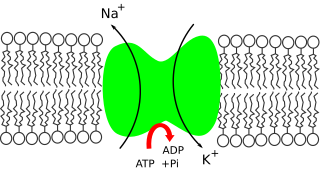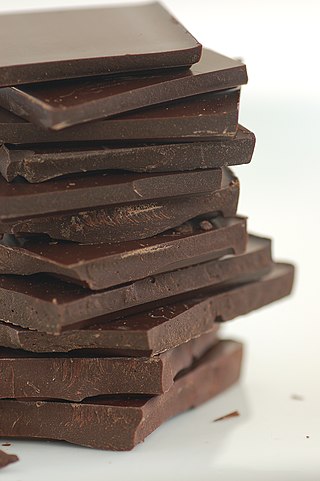
Chocolate, or cocoa, is a food made from roasted and ground cacao seed kernels that is available as a liquid, solid, or paste, either on its own or as a flavoring agent in other foods. Cacao has been consumed in some form for at least 5,300 years starting with the Mayo-Chinchipe culture in what is present-day Ecuador. Later Mesoamerican civilizations also consumed chocolate beverages before being introduced to Europe in the 16th century.

Chocolate milk is a type of flavoured milk made by mixing cocoa solids with milk. It is a food pairing in which the milk's mouthfeel masks the dietary fibres of the cocoa solids.

Buttermilk is a fermented dairy drink. Traditionally, it was the liquid left behind after churning butter out of cultured cream. As most modern butter in Western countries is not made with cultured cream but uncultured sweet cream, most modern buttermilk in Western countries is cultured separately. It is common in warm climates where unrefrigerated milk sours quickly.

Potassium is the main intracellular ion for all types of cells, while having a major role in maintenance of fluid and electrolyte balance. Potassium is necessary for the function of all living cells, and is thus present in all plant and animal tissues. It is found in especially high concentrations within plant cells, and in a mixed diet, it is most highly concentrated in fruits. The high concentration of potassium in plants, associated with comparatively very low amounts of sodium there, historically resulted in potassium first being isolated from the ashes of plants (potash), which in turn gave the element its modern name. The high concentration of potassium in plants means that heavy crop production rapidly depletes soils of potassium, and agricultural fertilizers consume 93% of the potassium chemical production of the modern world economy.

Dutch processed cocoa, Dutch cocoa, or alkalized cocoa, is cocoa solids that have been treated with an alkalizing agent to reduce the natural acidity of cocoa, giving it a less bitter taste compared to "natural cocoa" extracted with the Broma process. It forms the basis for much of modern chocolate, and is used in ice cream, hot chocolate, and baking.

A chocoholic is a person who craves or compulsively consumes chocolate. The word "chocoholic" was first used in 1961, according to Merriam-Webster. It is a portmanteau of "chocolate" and "alcoholic". The term is used loosely or humorously to describe a person who is inordinately fond of chocolate; however, there is medical evidence to support the existence of actual addiction to chocolate. Psychoactive constituents of chocolate that trigger a ‘feel-good’ reaction for the consumer include tryptophan and phenylethylamine, which may contribute to cravings and addiction-like responses, particularly in people with specific genetic alleles. The quantity of sugars used in chocolate confections also impacts the psychoactive effects of chocolate.

White chocolate is a confectionery typically made of sugar, milk, and cocoa butter, but no cocoa solids. It is pale ivory in color, and lacks many of the compounds found in milk, dark, and other chocolates. It is solid at room temperature because the melting point of cocoa butter, the only white cocoa bean component, is 35 °C (95 °F).

Fudge Rounds are fudgy, round snack cakes made by the Little Debbie company. A Fudge Round consists of two chewy chocolate cookies with light brown fudge creme in between, and light brown fudge strips on top.

Chocolate spread is a sweet chocolate-flavored paste which is eaten mostly spread on breads and toasts or similar grain items such as waffles, pancakes, muffins, and pitas.

Weetos is a brand of chocolate-flavoured breakfast cereal produced by Weetabix Food Company. The name comes from the fact that its primary ingredient is wheat (Weet-) and the cereal pieces are in O shapes (-Os), the same naming convention that is used on the company's flagship cereal Weetabix.

Milk Duds are a brand of candies made with chocolate, created in 1928 by Hoffman and Company of Chicago and now produced and marketed by The Hershey Company, under license from owners of the brand, Highlander Partners, a Dallas-based global private equity firm.

Kinder Chocolate is a chocolate bar produced by Italian multinational confectionery company Ferrero.

Pocket Coffee is a brand of the Ferrero company for a chocolate confectionery, sold internationally. First marketed in Italy in 1968, each Pocket Coffee is an individually wrapped shell of dark chocolate containing liquid espresso. As with Ferrero's Rocher, Mon Chéri, and Raffaello, production limits sales from November to April.

Baking chocolate, or cooking chocolate, is chocolate intended to be used for baking and in sweet foods that may or may not be sweetened. Dark chocolate, milk chocolate, and white chocolate are produced and marketed as baking chocolate. However, lower quality baking chocolate may not be as flavorful compared to higher-quality chocolate, and may have a different mouthfeel.

Kudos was a milk chocolate granola cereal bar produced by Mars, Incorporated.

Kinder Bueno is a chocolate biscuit and wafer confection made by Italian confectionery maker Ferrero. Part of the Kinder Chocolate brand line, Kinder Bueno is a hazelnut-cream-filled wafer covered in milk chocolate and a dark chocolate drizzle.

Chocolate ice cream is ice cream with natural or artificial chocolate flavoring. One of the oldest flavors of ice creams, it is also one of the world's most popular. While most often sold alone, it is also a base for many other flavors.

Breakaway was a brand of chocolate-covered digestive biscuit from Nestlé, which started production in 1970 in the United Kingdom, manufactured by Rowntree Mackintosh Confectionery. Nestlé acquired the brand in 1988. It was discontinued in February 2024 after 54 years due to falling sales.

Hershey's Cookies 'n' Creme is a candy bar manufactured by The Hershey Company and first introduced in 1994.

Dry cocoa solids are the components of cocoa beans remaining after cocoa butter, the fatty component of the bean, is extracted from chocolate liquor, roasted cocoa beans that have been ground into a liquid state. Cocoa butter is 46% to 57% of the weight of cocoa beans and gives chocolate its characteristic melting properties. Cocoa powder is the powdered form of the dry solids with a small remaining amount of cocoa butter. Untreated cocoa powder is bitter and acidic. Dutch process cocoa has been treated with an alkali to neutralize the acid.





















